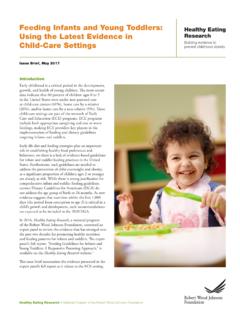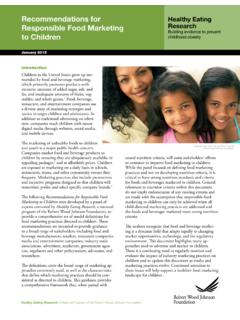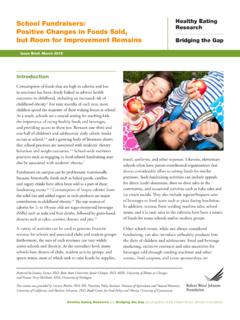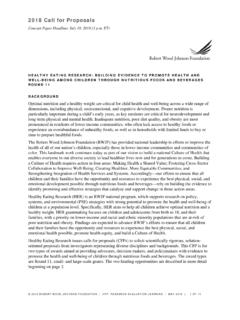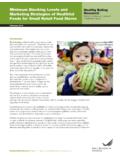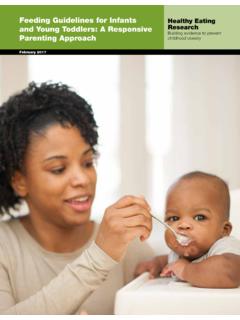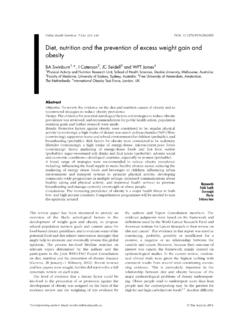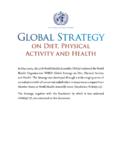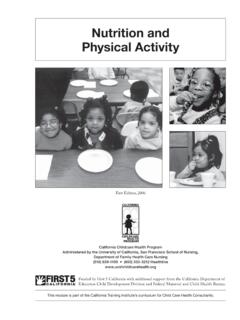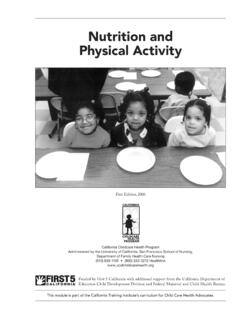Transcription of Promoting Good Nutrition Healthy Eating and Physical ...
1 Promoting good Nutrition Healthy Eating and Physical activity in Research Building evidence to prevent Child-Care Settings childhood obesity A Research Brief, May 2007. Child-care facilities provide a valuable opportunity to promote Healthy Eating and Physical activity behaviors in children. The alarming rates of obesity among children in the United States make the opportunity to introduce Healthy behaviors during early childhood especially important. Between 1971 and 2004, the rate of obesity among children ages 6 to 11 years increased nearly fivefold (from 4 percent to 19 percent), and the rate among preschool children ages 2 to 5 years nearly tripled (from 5 percent to 14 percent.)
2 1, 2 Today, one-third of all children and adolescents in the are either obese or at risk for becoming There are serious health and economic consequences associated with obesity. Children who are obese or at risk for obesity have a greater likelihood of being obese in adulthood and developing heart disease, diabetes and other serious health In addition to the extraordinary toll on our nation's health, obesity also poses a tremendous financial burden, with costs estimated at $117 billion Poor diet and Physical inactivity are major contributors to obesity, and the early childhood years are an important period for developing Healthy food preferences and motor , 5.
3 According to current data, only about one-quarter of children ages 2 to 11 years consume three daily servings What child-care arrangements and programs of vegetables, and less than one-half of those children are used by children in the consume two daily servings of In addition, very few children achieve recommended levels of Child-care arrangements in the may be classified Physical broadly as relative care, home-based non-relative care and center-based Care provided by a babysitter, The proportion of working mothers with young children neighbor, friend or other non-relative may be provided increased from 39 percent in 1975 to 63 percent in in a child's home or the provider's home.
4 Non-relative As a result, child-care use is also on the rise. The majority providers who care for two or more children are classified (60 percent) of infants and children up to age 5 spend as family child-care providers. Center-based care includes an average of 29 hours per week in some form of child- child-care centers, nursery schools, preschools and Head care Although older children spend a substantial Start programs. Use of multiple care arrangements is amount of time in school, more than half of young not uncommon. The distribution of arrangements for people ages 5 to 14 years also spend time in a regular children from birth to age 5 is as follows: child-care 35 percent receive relative care.
5 Given the widespread and increasing use of child care, 22 percent receive home-based, non-relative care; and it is important to understand the potential for child-care settings to have an influence on the development of 60 percent receive center-based obesity among children. The purpose of this brief is to School-aged children also may spend time in community- present an overview of research that has examined the based enrichment activities ( , sports, lessons, clubs nutritional quality of meals and snacks, opportunities and after-school programs). for Physical activity and the outcomes of interventions designed to prevent obesity in child-care settings.
6 Healthy Eating Research A National Program of the Robert Wood Johnson Foundation What types of federal support exist for To be eligible for reimbursement, CACFP guidelines child care programs? require that meals and snacks include a minimum number of age-appropriate servings from four food Family child-care homes and center-based care programs categories: fluid milk; vegetables, fruit or 100 percent that are licensed or approved to provide services may be juice; grains or bread; and meat or meat alternates eligible to receive federal support for the meals and snacks (Table 1).11 However, CACFP guidelines do not they serve to children ages 12 years and The require meals and snacks to meet any nutrient-based Child and Adult Care Food Program (CACFP), jointly standards and do not prohibit child care providers administered by the Department of Agriculture and from offering additional non-reimbursable foods or designated state agencies, provides meals and snacks for beverages low in Nutrition and high in calories.
7 There nearly million children in center-based care and almost are no funding provisions or legislative requirements 900,000 children in family child-care CACFP for Nutrition regulations and provisions are summarized below. Table 1. Child and Adult Care Food Program Meal Pattern Requirements for Children, Ages 1 through 12 Years*. Eligible programs include nonprofit child-care Breakfast Lunch or Supper Snack (include 3 (include all 4 (select 2 of the 4. centers, for-profit child- Food components* components) components) components). care centers that serve 25. percent or more low- Milk 1 1 1. income children, after- Vegetable/fruit/100% juice 1 2 1.
8 School care programs, Grains/bread 1 1 1. Head Start programs and other institutions that Meat/meat alternate 1 1. are licensed or approved * Table reflects the required number of servings from these food component categories for the particular meal or snack being served. to provide child-care The required serving size varies according to the age of the child and the meal or snack being served. Required serving sizes can As family child- be found at care businesses tend to Reference 11. be small, participation Head Start and Early Head Start are federal child is limited to businesses that have a sponsoring development programs serving low-income children organization.
9 Sponsors serve as intermediaries between ages 3 to 5 years and low-income children from birth businesses and the designated state administrative to age 2, In 2005 more than 900,000. agency and ensure that centers comply with federal and children were served by 19,000 centers across the state CACFP regulations. The overall goal of both programs is to increase For each child enrolled in an eligible program, the the school readiness of young children in low-income CACFP provides funding reimbursement to child-care To achieve this goal, a comprehensive range centers and family child-care providers for up to either of services are provided to young children, including two meals and one snack or one meal and two snacks educational, medical, dental, mental health and daily.
10 After-school programs can receive reimbursement 11 Nutrition services. for one snack if at least half of the children are eligible for free or reduced-price meals based on school data. A number of federal regulations specifically address the Meals and snacks served to children in child-care centers, promotion of Healthy Eating and Physical activity . These Head Start and after-school programs are reimbursed at regulations ensure that: 1) parents receive guidance on rates based on the type of meal served ( , breakfast, Nutrition and Physical activity ; 2) facilities participate in lunch or supper) and a child's eligibility for free, the CACFP; 3) meals and snacks provide one-third to reduced-price or paid meals and snacks.


